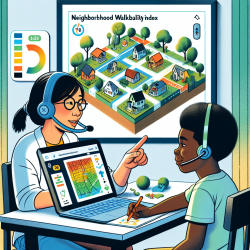Introduction
In the realm of speech-language pathology, especially within online therapy services like those offered by TinyEYE, understanding the broader environmental factors that influence health and behavior is crucial. Recent research, such as the study titled "Associations between neighborhood walkability and walking following residential relocation: Findings from Alberta's Tomorrow Project," provides valuable insights that can be translated into practice to improve therapy outcomes for children.
Understanding the Research
The study conducted by McCormack et al. (2023) explores how changes in neighborhood walkability, resulting from residential relocation, impact walking behaviors. The research highlights that adults who move to less walkable neighborhoods experience a significant decrease in transportation walking. This finding underscores the importance of the built environment in promoting physical activity, which is a critical component of overall health and well-being.
Implications for Online Therapy
While the study focuses on adults, its implications can be extended to children, particularly in understanding how environmental factors influence behavior and learning. Here are some ways practitioners can integrate these insights into their practice:
- Contextual Understanding: Recognize that a child's environment, including neighborhood walkability, can affect their engagement and progress in therapy. Consider discussing environmental factors with parents to better tailor therapy sessions.
- Encouraging Physical Activity: Advocate for increased physical activity as part of a holistic approach to therapy. Encourage families to explore their neighborhoods and engage in walking activities, which can support cognitive and language development.
- Customized Therapy Plans: Develop therapy plans that incorporate movement and outdoor activities, especially for children in less walkable neighborhoods. This can help mitigate the negative effects of a less supportive environment.
Encouraging Further Research
Practitioners are encouraged to delve deeper into how neighborhood characteristics influence therapy outcomes. Conducting small-scale studies or surveys within your practice can provide valuable data to further tailor therapy approaches. Collaboration with urban planners and public health professionals can also lead to more comprehensive strategies that address environmental factors impacting therapy success.
Conclusion
The findings from the Alberta's Tomorrow Project offer a compelling case for considering environmental factors in therapy planning. By integrating insights from neighborhood walkability research, practitioners can enhance their understanding of the contexts in which children live and learn, ultimately leading to more effective therapy outcomes.
To read the original research paper, please follow this link: Associations between neighborhood walkability and walking following residential relocation: Findings from Alberta's Tomorrow Project.










